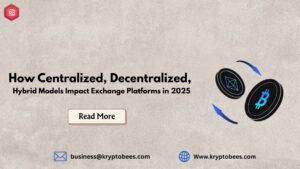By 2025, the way digital asset exchange platforms are set up will have a significant impact on how traders interact with them. The difference between centralized, decentralized, and hybrid models now dictates how exchanges function, how users engage, and how markets move. For any Crypto Exchange Development Company, it is no longer just an architectural issue; it’s a strategic one. Every model has a different effect on efficiency, innovation, regulation, and trust.
Centralized Exchanges: Evolving With Regulation and Scale
Centralized exchanges (CEXs) remain dominant in terms of trading volume and user adoption. Their established infrastructure, deep liquidity pools, and high-frequency trading capabilities make them ideal for large-scale operations. In 2025, CEXs are more than just trading platforms; they have become full-service financial hubs.
Regulatory clarity is driving significant changes in how centralized platforms operate. Exchanges are investing heavily in compliance tools, such as advanced KYC/AML systems, integrated tax reporting, and jurisdiction-specific onboarding. The demand for custodial assurance has led to the widespread use of multi-party computation (MPC) wallets and real-time proof-of-reserves reporting to maintain transparency and client trust.
Additionally, CEXs are expanding their functionality to support real-world asset (RWA) trading and tokenized securities. The integration of traditional financial instruments with crypto-native features is helping these platforms attract institutional users and global investors. However, concerns around central control, single points of failure, and regulatory overreach continue to push certain users to explore decentralized alternatives.
Decentralized Exchanges: Moving Into the Mainstream
Decentralized exchanges (DEXs) have matured significantly since their early experimental days. By 2025, they will have become credible, widely used platforms driven by permissionless innovation and user sovereignty. Built on smart contracts and blockchain technology, DEXs allow peer-to-peer trading without centralized intermediaries.
The appeal of self-custody has grown substantially. More users are now aware of the risks associated with centralized custody and are choosing to manage their assets through decentralized wallets. This shift in behavior is driving usage on DEXs, where users retain control of their private keys and interact directly with protocols.
Technological advancements such as Layer 2 scaling and improved user interfaces have helped DEXs overcome early limitations related to slippage, gas fees, and transaction speed. Additionally, cross-chain interoperability is enhancing liquidity, enabling users to move assets seamlessly between blockchains and trade in multi-chain environments.
Despite these advancements, DEXs still face challenges, particularly when it comes to fiat onramps, user onboarding, and protection against smart contract exploits. Nevertheless, in regions with financial restrictions or regulatory uncertainty, decentralized platforms are providing an essential lifeline for global asset access.
Hybrid Models: Blending the Strengths of Both Worlds
Hybrid exchanges are becoming the go-to architecture for developers and enterprises seeking the best of both centralized and decentralized worlds. These platforms are designed to offer centralized performance while maintaining decentralized principles around custody and transparency.
In a typical hybrid setup, trade matching is handled off-chain for speed, while settlement occurs on-chain to ensure security and auditability. This combination delivers high performance and resilience, especially for users who prioritize both speed and control over their assets.
Hybrid exchanges in 2025 are also using flexible compliance frameworks, allowing platforms to implement regulatory measures based on the user’s jurisdiction. This adaptability opens doors to broader market participation without sacrificing the decentralized ethos.
Liquidity aggregation is another strength of the hybrid model. By tapping into both centralized order books and decentralized liquidity pools, hybrid exchanges offer competitive pricing and minimized slippage, enhancing the trading experience across all user types.
The Strategic Impact Across the Exchange Ecosystem
The model an exchange chooses has wide-reaching implications across its ecosystem. User behavior, for instance, is shifting toward multi-platform strategies. Traders are using aggregators and smart routers to find the best rates across CEXs, DEXs, and hybrid platforms. They are not loyal to a single type; they follow performance, pricing, and control.
Security models are evolving as well. Rather than relying on a one-size-fits-all approach, platforms now implement modular security depending on their architecture. These range from centralized custody systems with institutional-grade safeguards to decentralized models protected by smart contract audits and multisig wallets.
Geopolitical factors are also influencing platform architecture. DEXs and hybrid platforms are emerging as key enablers of cross-border finance in regions that restrict capital flow or crypto access. This dynamic is shaping not just the future of exchanges but also the future of financial inclusion on a global scale.
Conclusion
In 2025, centralized, decentralized, and hybrid exchange models each serve distinct purposes, and their coexistence is redefining what a digital trading platform can be. Centralized exchanges bring scale and compliance, decentralized ones offer autonomy and censorship resistance, and hybrid models blend performance with control. For businesses looking to launch their platform, solutions like the Binance Clone Script offer a reliable blueprint, replicating Binance’s powerful architecture while enabling customizations tailored to today’s evolving trading needs.
Companies like Kryptobees are leading this transformation, known for delivering projects on time with over 100 client reviews praising their professionalism and execution. Whether you’re an investor, developer, or founder, understanding the strengths and trade-offs of each exchange model and working with seasoned partners can accelerate your success. The exchange space is no longer divided by ideology but united by one shared goal: giving users better access, transparency, and efficiency in the digital economy.